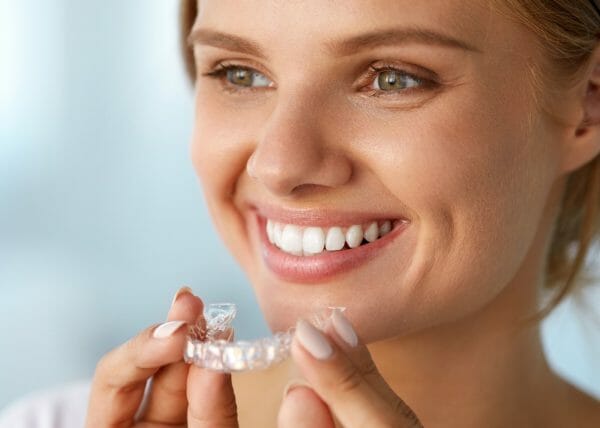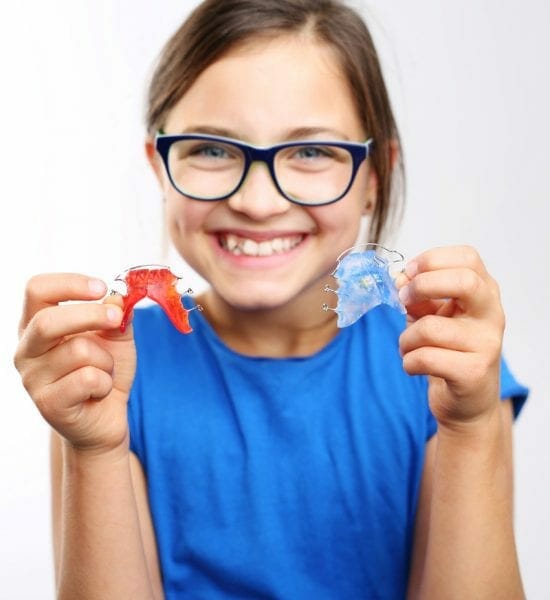The Big Day
Having braces taken off is an exciting experience. After all, a beautiful smile is a great reward for your time invested in transforming your smile. Dr. Ryan Redford and his experienced staff know this special day is one that many kids and teens anticipate.
Even though the braces have been removed, there are several after-care practices that need to be kept in mind.

Teeth Whitening
Patients love inspecting their beautiful, new smile right after the braces are removed. In some cases, there may be a slight difference in tooth color where the brackets were adhered to the teeth. This can be for a few different reasons.
Some people have subtle intrinsic color variations on their teeth that are natural and unique to them.
If the patient used whitening toothpaste while wearing their braces, the places that were not able to be brushed (such as underneath the brackets or Invisalign attachments) may appear slightly more yellow when they are removed. This is simply because the tooth color was lightened everywhere but in those small areas. For this reason, the use of whitening toothpaste during orthodontic treatment (both braces and Invisalign) is not advised.
Alternatively, patients that had poor oral hygiene habits during braces or Invisalign may notice that the areas where the brackets were adhered are a different color than the surrounding tooth. Often referred to as “white spot lesions”, these areas are typically near the gum line where the enamel of the tooth experienced decalcification from plaque accumulation. White spot lesions are completely preventable with good oral hygiene. Good brushing and flossing is critical to avoid these.
The good news is there is a fix for these issues. In most cases, brushing with enamel-safe whitening toothpaste in the days and weeks following braces removal will quickly and safely remove any discoloration that may be noticeable. In more significant cases, professional tooth whitening, a technique called “resin infiltration”, or restoration of teeth with composite bonding or veneers may be suggested.
While most patients are happy and satisfied with the color of their teeth after orthodontic treatment, some simply want to have their teeth whitened to brighten their smile. Our orthodontists advise that patients seek professional whitening from their family dentist. If a patient does not have a regular family dentist, our orthodontists will recommend a trustworthy local dental office for care.

Invisalign
Braces and Invisalign each have their individual pros and cons. Braces are typically more precise and require less patient cooperation. Clear aligner treatment (Invisalign) is less visible and facilitates easier oral hygiene. This is because Invisalign clear aligners are removable. Removing them to brush and floss decreases the chances of decalcification of tooth enamel during treatment. This can mean a reduction in possible tooth discoloration.
On the other hand, clear aligners cover the entire surface of all teeth. So, if the trays are not cleaned well after eating, or if sugary beverages are consumed while the aligners are in the mouth, plaque and bacteria will be held closely to the teeth throughout the day. This could result in discoloration of teeth very quickly.
Additionally, because tooth colored “attachments” are placed on select during Invisalign treatment, avoiding whitening toothpastes and gels during treatment is advised. Of course, using a whitening tooth paste or having your dentist professionally whiten your teeth after Invisalign for an aesthetic boost is a great option.
Invisalign for teens uses clear aligners that can be removed for brushing and flossing. The only difference from adult Invisalign is that this technologically advanced version has features designed specifically with teens in mind.
Good Hygiene
The orthodontic outcome that braces give children and teens may be undermined if good oral hygiene practices are not maintained after treatment is complete. Daily brushing, flossing, and biannual cleanings are the cornerstone of continued oral health.
Cavities and tooth decay can quickly steal the spotlight from the aesthetic improvements that braces create. Red and inflamed gums due to gum disease also detracts from a beautiful smile. Gum disease that is left untreated can lead to receding gums and even tooth loss.
Straight teeth are easier to keep clean than tightly spaced, misaligned teeth. This is one of the many benefits in seeking orthodontic treatment for children. A child that may have otherwise struggled to brush thoroughly or floss properly should see a drastic improvement once braces are removed.
Evenly aligned teeth are simpler to floss between. Straight teeth are easier to access, and plaque is easily removed from the surfaces of teeth. Plaque that is not removed hardens into tartar. Tartar along the gumline harbors harmful bacteria and is a leading cause of gum disease.

Healthy Diet
Continuing the so-called “braces diet” after having braces removed is a great idea for good oral health. The dietary limitations and recommendations that orthodontic patients experience is not only good for physical wellness, but they are also healthy choices for teeth and gums as well. It is common knowledge that sugar is bad for teeth. Why? Sugar affects teeth in a few different ways.
- Bacteria – Studies show certain harmful bacteria found in the mouth produce acid when sugar is ingested. The sugar feeds the bacteria, and the acid can erode enamel and leads to cavities and tooth decay.
- pH – The ideal pH of a healthy mouth is balanced at 6.2 to 7.6. Eating sugar can cause the pH of the mouth to lower, thereby creating an acidic environment, which is bad for teeth.
- Plaque – Plaque is the sticky film that covers teeth especially after eating sugary snacks. If this film is not removed, it can harden into tartar that is unhealthy for teeth and gums.
- Stickiness – Sweet and starchy or sticky snacks that are harder to remove like chewy or gummy candy will linger in the mouth longer after eating. It tends to stick to teeth and gives harmful bacteria extra time to ingest them and produce even more harmful acid.
When indulging in sweet snacks, it is important to brush approximately one hour afterward. Rinse vigorously with water when brushing is not possible.
A balanced diet of vegetables, fruits, whole grains, and healthy sources of protein is a much better choice for a child’s oral health.
Retainers
When braces are removed, the next step in the process of preserving your new smile is a retainer. If a retainer is not worn after braces are removed, teeth can and will likely shift back to incorrect positions. It may not be noticeable immediately, but teeth are especially prone to shifting in the first several months after braces are removed.

When the pressure of the braces is removed, the ligaments that hold teeth into position activate their muscle memory. This increases the risk of shifting, especially during this pivotal time right after treatment.
It is imperative to wear the retainer exactly as instructed by Burke & Redford Orthodontists’ doctors. Failing to do so can lead to misalignment of teeth or a person’s bite. If too much shifting has taken place, the custom-made retainer will no longer fit properly.
In most cases, our orthodontists will advise a bonded (otherwise known as fixed or permanent) retainer for the lower teeth where unwanted tooth movement is most likely to occur.
As time goes on, teeth will tend to shift naturally as part of the aging process. Patients should continue wearing a retainer for as long as they want their teeth to remain straight (indefinitely).
Types of Braces
There are several types of braces that will create a beautiful smile for kids and teenagers. No matter which types of braces are used, good oral hygiene and using a retainer as instructed are all key parts in maintaining good oral hygiene.
Metal braces are a great choice in orthodontic care and are still the standard of care. If your child has crooked teeth or problems with their bite, metal braces can be a great solution.

Ceramic braces are another popular choice. They straighten teeth just as well as metal braces but have a reduced appearance. The brackets are made of ceramic, which can be clear or tooth colored. White wires are also available and blend in well with the color of the teeth.
Self-ligating braces use technologically advanced open-and-close door mechanisms to secure the archwire to the brackets instead of ligatures. The main advantage of these systems are the quicker adjustment appointments.
Damon braces are a popular brand of self-ligating braces available through most orthodontic offices.

Getting a head start on your child’s orthodontic treatment is key to getting the best orthodontic result. Dr. Redford recommends starting between the ages of 7 and 11 for interceptive orthodontic treatment. Give us a call during business hours at (951) 699-8011 or schedule a Free Orthodontic Consultation for your child through our website anytime.